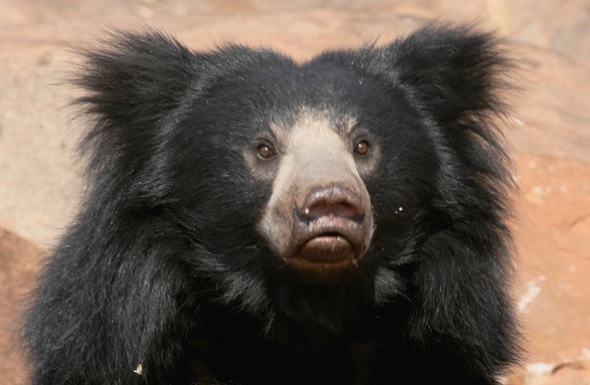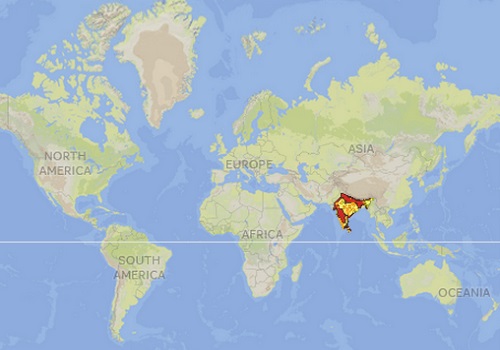Taxonomy
Kingdom |
Phylum |
Class |
Order |
Family |
Genus |
Species |
| Animalia | Chordata | Mammalia | Carnivora | Ursidae | Melursus | Melursus ursinus |
0

Adult sloth bear from the Daroji Bear Sanctuary
0
Name
- Common name: Sloth bear.
- Scientific name: Melursus ursinus
- Sloth bears are not related to sloths. George Shaw, a European zoologist, believed they were related. He named this species for features they share with tree sloths such as their long, thick claws and teeth and the fact that sometimes they hang upside down on tree branches.
Distribution and Habitat
- Sloth bears live in South Asia in the Indian Subcontinent covering the countries of Bangladesh, Bhutan, India, Nepal and Sri Lanka.
- Its population is highly fragmented due to loss of habitat. It may be extinct in Bangladesh; the last documented records are from the late 1990s.
- Their habitat consists of lowland tropical forest, grasslands, scrublands and savannas.

Sloth Bear Distribution Map. Source: IUCN Red List of Threatened Species. Extinct in red areas.
Physical Features
- Sloth bears are covered in shaggy heavy black coat. The hair of its coat is long and measures from 80 to 200 mm. It is longer on the neck and shoulders.
- Their snout is very long and cream colored.
- They have a long tongue and a gap on their teeth that allows them to suck up ants, termites and bees. Their nostrils can close to protect themselves against insects.
- Their claws are curved and long and measure 3 in or 7.6 cm. They are used to penetrate termites in logs, soil or trees.
- They have a cream colored “V” or “Y” patch on their chest and tufts of hair on the ears.
Length and Weight
- Males are 30 to 40% heavier than females.
- Sloth bears grow up to 6 feet or 1.8 meters in length.
- Males can weigh up to 310 lbs or 140 kg while females up to 210 lbs or 95 kg.
Reproduction
- Sloth bears breed during the months of June and July.
- The female builds a den under a fallen log or in the cavity of a tree and prepares it to give birth.
- Gestation period is from 6 to 7 months.
- Litter size is one or two. Cubs are born from November to January.
- Cubs remain with their mothers for 2 to 3 years. Males do not participate in the rearing of cubs.
Behavior
- Sloth bears are solitary animals unless is mating season or a female is rearing cubs.
- They are most active at night when there is human activity. In protected areas they are active during the day.
- They use their lips as vacuum to suck in insects from their nests.
- They climb trees to knock down honeycombs which they will eat on the ground.
- When threatened they will attack by standing on two legs and using their forepaws as weapons.
- Sloth bears have a keen sense of smell but their hearing and eye sight are poor.
- They do not hibernate but have a period of inactivity during the rainy season.
Diet
- Sloth bears are omnivorous.
- Their diet mainly consists on termites, ants, fruits and flowers.
- During food shortages they will eat carrion.
Life Expectancy
- In captivity sloth bears can live up to 40 years.
Predators
- Humans are their main predators.
- Natural predators are leopards (Panthera pardus) and tiger (Panthera tigris).
Threats
- The IUCN estimates that there are around 20,000 individuals in the wild with a decreasing population trend. There has been a 30 to 50% population decline over the past 30 years.
- Habitat loss due to human settlement, development and industrialization.
- Poaching and trade in sloth bear parts for traditional medicine.
- Increasing number of encounters between humans and bears which lead to their death.
Conservation Status
- The IUCN Red List of Threatened Species lists the sloth bear as a vulnerable species.
- According to the IUCN there are 174 Protected Areas in India.
- Sloth bears are listed under Appendix 1 of CITES.
- In India they are protected under Schedule 1 of the Indian Wildlife Protection Act.
Did you know?
Sloth bears are the only species of bears to carry their young on their back.
Related Bear Species
 |
 |
 |
 |
| Bear, Andean or Spectacled |
Bear, Asiatic Black |
Bear, Black | Bear, Brown |
 |
 |
 |
 |
| Bear, Giant Panda | Bear, Polar | Bear, Sloth | Bear, Sun |
References and further research
Smithsonian National Zoological Park – Sloth Bear
IUCN Red List of Threatened Species – Melursus ursinus
University of Michigan Museum of Zoology – Melursus ursinus sloth bear
World Association of Zoos and Aquariums WAZA – Sloth Bear
